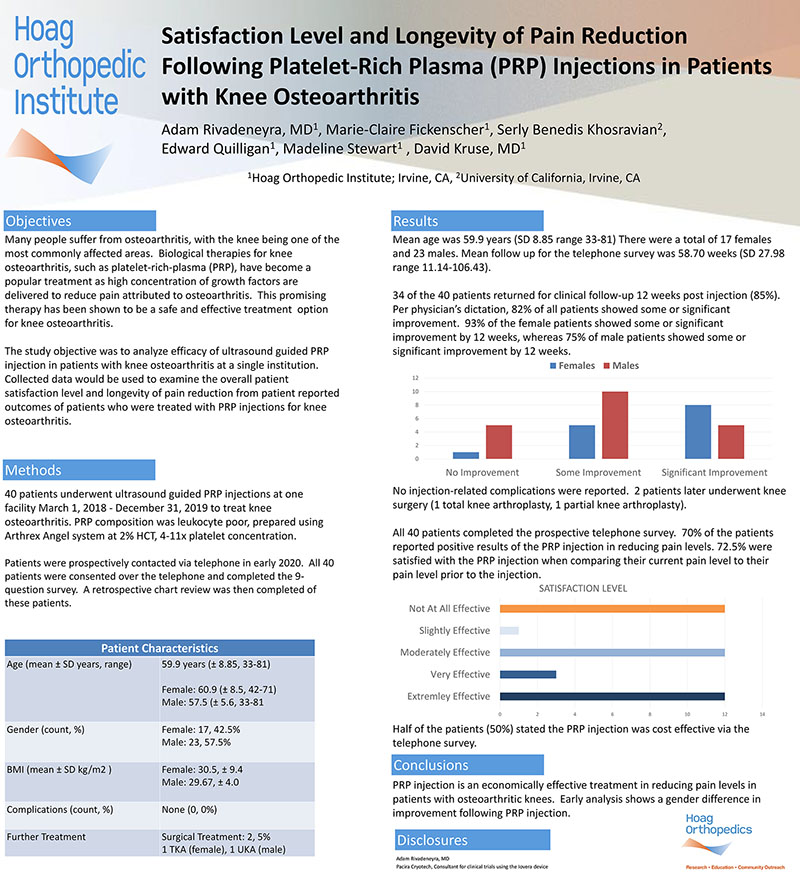
Hover to pan and click to magnify. Click again to pan at full screen.
Adam Rivadeneyra, MD, Marie-Claire Fickenscher, Serly Benedis Khosravian, Edward Quilligan, Madeline Stewart , David Kruse, MD
Adam Rivadeneyra, MD, Marie-Claire Fickenscher, Serly Benedis Khosravian, Edward Quilligan, Madeline Stewart , David Kruse, MD
Hoag Orthopedic Institute; Irvine, CA, University of California, Irvine, CA
Objectives
Many people suffer from osteoarthritis, with the knee being one of the most commonly affected areas. Biological therapies for knee osteoarthritis, such as platelet-rich-plasma (PRP), have become a popular treatment as high concentration of growth factors are delivered to reduce pain attributed to osteoarthritis. This promising therapy has been shown to be a safe and effective treatment option for knee osteoarthritis. The study objective was to analyze efficacy of ultrasound guided PRP injection in patients with knee osteoarthritis at a single institution. Collected data would be used to examine the overall patient satisfaction level and longevity of pain reduction from patient reported outcomes of patients who were treated with PRP injections for knee osteoarthritis.
Methods
40 patients underwent ultrasound guided PRP injections at one facility March 1, 2018 - December 31, 2019 to treat knee osteoarthritis. PRP composition was leukocyte poor, prepared using Arthrex Angel system at 2% HCT, 4-11x platelet concentration. Patients were prospectively contacted via telephone in early 2020. All 40 patients were consented over the telephone and completed the 9-question survey. A retrospective chart review was then completed of these patients.
Results
Mean age was 59.9 years (SD 8.85 range 33-81) There were a total of 17 females and 23 males. Mean follow up for the telephone survey was 58.70 weeks (SD 27.98 range 11.14-106.43). 34 of the 40 patients returned for clinical follow-up 12 weeks post injection (85%). Per physician’s dictation, 82% of all patients showed some or significant improvement. 93% of the female patients showed some or significant improvement by 12 weeks, whereas 75% of male patients showed some or significant improvement by 12 weeks.
No injection-related complications were reported. 2 patients later underwent knee surgery (1 total knee arthroplasty, 1 partial knee arthroplasty). All 40 patients completed the prospective telephone survey. 70% of the patients reported positive results of the PRP injection in reducing pain levels. 72.5% were satisfied with the PRP injection when comparing their current pain level to their pain level prior to the injection.
Half of the patients (50%) stated the PRP injection was cost effective via the telephone survey.
Conclusions
PRP injection is an economically effective treatment in reducing pain levels in patients with osteoarthritic knees. Early analysis shows a gender difference in improvement following PRP injection.
Disclosures
Adam Rivadeneyra, MD
Pacira Cryotech, Consultant for clinical trials using the Iovera device

Present with Google Meet
Invite as many as 30 people, and present your poster in high definition. Transcription option is available. Free to use.
DISQUS COMMENTS WILL BE SHOWN ONLY WHEN YOUR SITE IS ONLINE